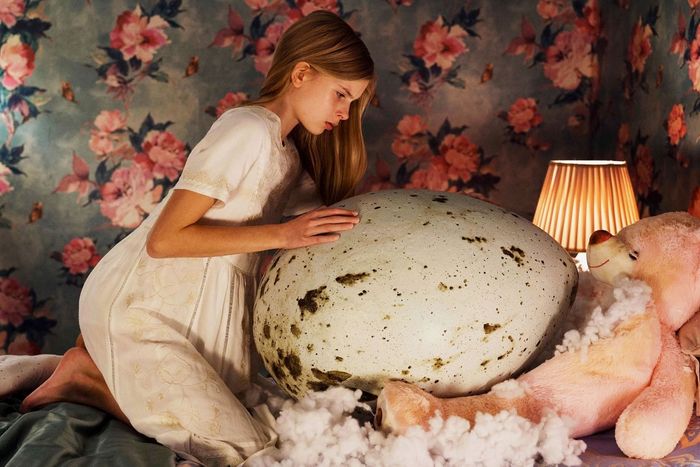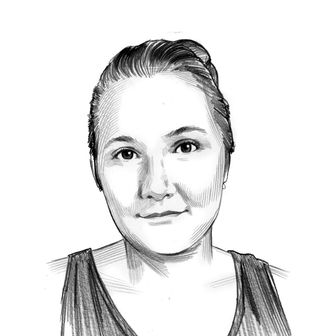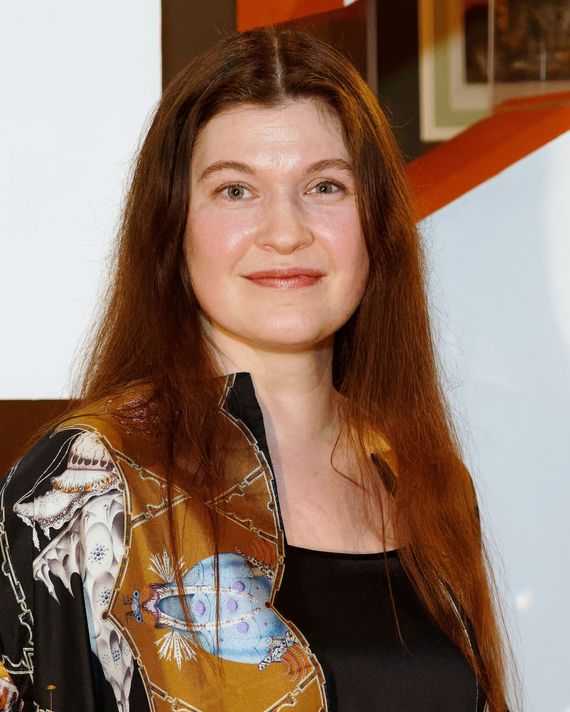
Being a woman is disgusting. That’s the takeaway from Finnish horror movie Hatching, which tells the story of a young gymnast named Tinja who nurtures an egg she finds in the woods. Burdened by the overbearing expectations of her mommy-blogger mother, Tinja channels all her fear, rage, and neediness into the creature that emerges. She names the creature Alli, after a lullaby Mother sings, and does her best to care for it, even when it starts to prove more wild than Tinja’s carefully curated life can handle. As it goes with most tween girls, things get bloody.
Hatching is director Hanna Bergholm’s feature debut, but she recruited a team of industry veterans to engineer the creature puppet that is Alli, a wholly original creation equal parts disgusting, terrifying, and endearing. Vulture caught up with Bergholm over Zoom to chat about monstrous mothers, doppelgängers, and what she’s working on next. (Hint: She’s not done talking about the messy business of womanhood.)
The last year or so has been full of sad movie moms, but Hatching has one of the darkest takes on mothering we’ve seen in a while. What made you decide to explore that darkness through mommy blogging?
Well, actually, in our first screenplay draft, we didn’t yet have the blogging there. It was just about a mother and a family who try to keep up appearances. Then I really started to think about, What is today’s way of keeping up appearances?, and I think that is really social media. Mother became this kind of blogger person, and then the whole story really started to come into place.
So she was originally just a suburban mom?
Yeah, exactly. What I really want to show is this mother-daughter relationship where the mother sees the daughter as something that belongs to her, there for her to fulfill her ambitions and some of her unfulfilled dreams.
The doppelgänger is another horror trope present in Hatching. Alli starts to look like Tinja, and Mother is making Tinja into a version of herself. And even Mattias, Tinja’s younger brother, looks like Father, kind of hilariously.
When the screenwriter Ilja Rautsi and I developed the script together, we discussed using that trope to show how this girl feels that she’s not accepted fully as she is, so she has to hide some of her emotions, some sides of her character. And she puts all of that into this doppelgänger, which represents her aggressions and sorrow and neediness and imperfections. I really wanted to show how to see yourself as full person, how to see your flaws as well and face them. Also, in this mother-daughter relationship, what usually happens is that the parent sees her own flaws in her child. My theory is that maybe that is why it is so difficult for Mother to see this monster: because it reminds her of her own flaws.
We get just a glimpse of Mother’s past in figure skating. It seems like there was an injury that took her out, which is why she’s pushing Tinja so hard in gymnastics. Did you originally have a more fleshed-out backstory for Mother?
We didn’t want to have any bigger backstory for her. It always was just this sense of failing in sports and having the scar. That was all we discussed. We improvised a couple of scenes from Mother’s past with [the actor, Sophia Heikkilä], but that was always just about her having to quit figure skating and how horrible that felt. I never really wanted to go deeper into her, for example, family history. I wanted to leave that out and let everybody imagine what her own childhood had been, because she seems like a person who can’t really feel love, I think.
The look on Tinja’s face when Mother says she hadn’t felt love until having an affair is heartbreaking. Was it hard to find such a young actress who could convey Tinja’s emotional journey as well as Alli’s?
Yes, that was a long process because it’s such a demanding double role. We auditioned 1,200 girls all around Finland for that part. Then we found Siiri Solalinna, and she had never acted anywhere before, not even in school plays. She was just a natural talent and so wonderful.
We had long rehearsals with her and with all the actors. The main thing for me was that she feels comfortable with all of these professional actors and feels comfortable screaming and crawling on the floor. In the rehearsals we all crawled on the floor playing monsters and just getting to know each other.
For me, it was also important that since this is kind of a heavy film with heavy topics, she can feel secure with herself. It was important to me that I always direct only the fictional emotions of this fictional Tinja character and not try to mess with her emotions. For example, when she’s portraying fear, she’s not scared herself.
No method acting for her.
Exactly, no method acting for her.
The movie works in broad strokes. Father stops asking questions when he sees blood in the bed and assumes that she’s just started her period. Tero, the handyman with whom her mother is having an affair, sees her throwing up and sort of assumes she’s bulimic. And even the billing of Mother and Father as simply Mother and Father, it’s almost folkloric.
Yeah, I really wanted to have that folkloric atmosphere. I wanted to kind of hint at the themes of puberty and getting our first periods and having an eating disorder. But in the film, Rautsi and I never wanted to name it as eating disorder, so everybody can interpret it as they like.
You’ve said you wanted to make this film for audiences that are traditionally afraid to watch horror movies. It’s still pretty scary!
Yes, but I’m actually one of them. I’ve always been afraid of horror films. Maybe that’s why I’m so interested in telling stories about fear, because I have such a strong imagination. When I watched The Others by Alejandro Amenábar, that was the eye opener film for me. Even though I had always thought, No, no, I don’t want to watch horror films, I saw how a dramatic story can be told in a horror genre. That is something we really wanted to do in this film, to tell a drama story through the horror genre. It’s actually interesting that the feedback from the audience has been that the horror fans have liked it, but also those who are afraid of horror films have luckily said, “Oh, I could watch it. And I liked it!”
It’s also funny!
That’s maybe my and Ilja’s way of looking at life. I think that when our situation is most tragic and we’re just trying to cope and keep ourselves together, we end up acting in very comical ways.
Hatching has a distinct visual style. All the pastels and florals contrast with the gore of birth and death. How did you determine what visual language the production would use?
I wanted it to feel how Tinja experiences it. She feels that she can’t really understand the dynamics in the family — there’s something weird about the relationship between Mother and Father. Even though Mother always acts in an almost loving way and speaks nicely, it seems like she never quite means what she says. I wanted to create that uneasy feeling for the audience. It’s not quite fairytale, not quite reality, but it’s something somewhere in between.
Also, I wanted to show the whole house as Mother has decorated it. She’s showing off her perfect happiness to the world — maybe trying to get some love and likes from her viewers through that. She doesn’t allow any strong feelings in the family, so there are no strong colors. Everything is kind of toned down, and she doesn’t allow any dark secrets. So there are no shadows, everything is very soft and light. I wanted to use all those things that are considered to be lovely, pastel colors and a lot of roses. There are so many roses that it’s kind of suffocating; everything is so in place and so controlled and organized that it looks kind of dead. For example, in sound design we did all these little things — for instance, in Tinja’s yard we never hear birds singing. In the neighbor’s yard they have birds, but not in Tinja’s. So there is this feeling of death all around them.
The Alli puppet is hard not to love, even as she starts harming dogs and children. How did you go about creating that puppet?
I always knew I didn’t want a digital monster, because I really wanted it to have physical presence. I wanted it to be an animatronic puppet, like E.T. I knew we needed the best possible person to make this puppet. We had to plan the design, the look of the puppet in Finland with the two concept artists. Then we needed the person to actually make it, so I Googled the best animatronic designer in the world and found Gustav Hoegen from London. He had been the lead animatronics designer in the latest Star Wars films, Jurassic World, and Prometheus. I emailed him and told him about this story, and he had just finished Star Wars and was excited to do something with a creature that is such an important character in the film. He collected himself a wonderful team. They were amazing.
We had five puppeteers moving its body with ropes, and Gustav was there moving the facial expressions and fingers with remote controls. That was a lot. Our footage in the edit looked very hilarious with all those puppeteers around the puppet.
Later on, Alli is played by an actor with special-effects makeup. For that I contacted Conor O’Sullivan, who has two Oscar nominations — he worked on Saving Private Ryan, The Dark Knight, and Game of Thrones.
Can you talk about the ending a little bit? Was the plan always for Tinja to be killed by Mother?
In the treatment we had some other ending and it wasn’t good; it felt wrong. When Ilja was about to start writing the first draft, we discussed and planned everything together except the ending. I was like, “Oh, then it ends. Write something. Just end it.” So Ilja was kind of writing toward the end without knowing what it is. But he figured it out.
It’s brutal. What was shooting that like? Was it hard for Siiri, or for you?
Well, there was blood all over and all different sizes of knives and body doubles and makeup changes. So practically, it was difficult. But Siiri told me that was the most fun day. She was just like, “Oh, it was so exciting, there were knives and blood and I could put the blood in my mouth and spit it out!” She was excited.
That’s adorable.
Usually it works out that the more scary an effect is onscreen, the less scary it is to shoot, because it’s more practical. It’s kind of just putting blood somewhere.
Sure, that makes sense. What was the hardest scene to shoot, practically?
That was always the puppet scenes, because it’s so demanding, and it’s a puppet, it’s not alive. You have to be very precise. It has to be very particular. All the movement has to be just right, otherwise it looks like a puppet. It needed multiple takes, even though they were such experts. That was very challenging, but also fun.
What are you working on next?
I’m now writing a new feature film with the same screenwriter, Ilja Rautsi. We are staying in a similar genre. It’s about a woman who gets her first child, and she’s very excited to be a mother, but when the baby’s born she feels that she can’t connect with the baby. The baby is scary and so demanding. It sucks blood from her breasts. She becomes convinced that this baby is actually not human. It’s about these difficult emotions of motherhood and aggressions that you might have.






